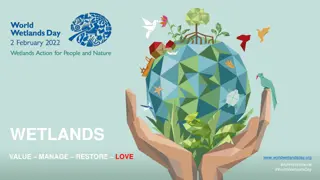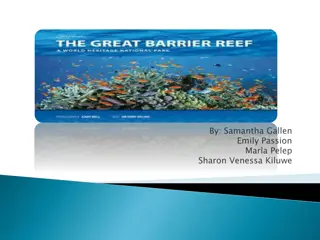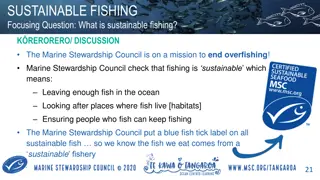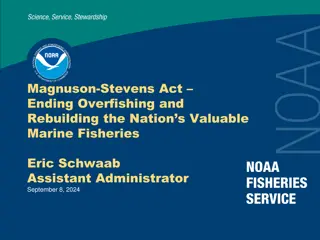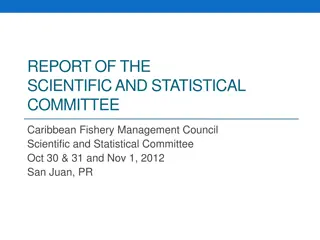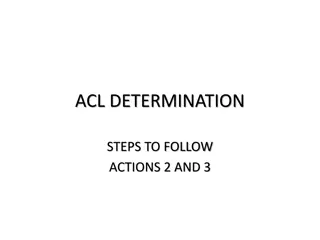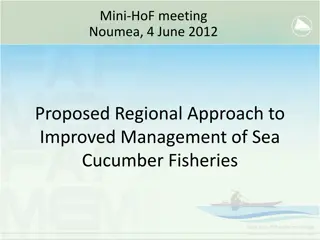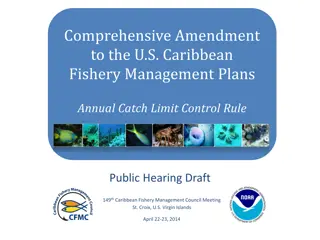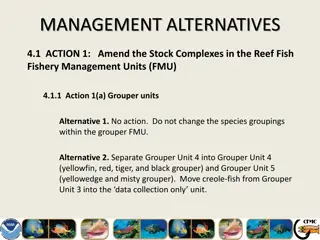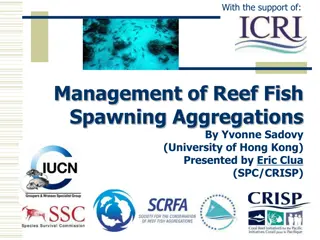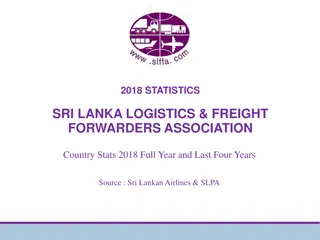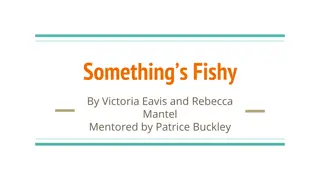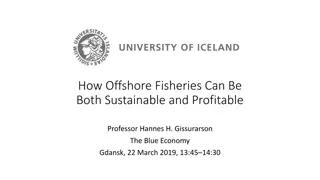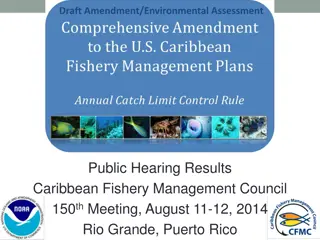
Overfishing and Its Impact on Marine Ecosystems
Overfishing is a pressing global issue that results from catching too much fish, depleting fish stocks, and disrupting marine ecosystems. Illegal fishing and subsidies exacerbate the problem, leading to significant environmental and economic consequences.
Download Presentation

Please find below an Image/Link to download the presentation.
The content on the website is provided AS IS for your information and personal use only. It may not be sold, licensed, or shared on other websites without obtaining consent from the author. If you encounter any issues during the download, it is possible that the publisher has removed the file from their server.
You are allowed to download the files provided on this website for personal or commercial use, subject to the condition that they are used lawfully. All files are the property of their respective owners.
The content on the website is provided AS IS for your information and personal use only. It may not be sold, licensed, or shared on other websites without obtaining consent from the author.
E N D
Presentation Transcript
What is overfishing? Overfishing can be defined in a number of ways. However, everything comes down to one simple point: Catching too much fish for the system to support leads to an overall degradation to the system. Overfishing is a non-sustainable use of the oceans. Over fishing is a form of overexploitation in which fish stocks are depleted to unacceptable levels. Overfishing has long been recognized as a leading environmental and socioeconomic problem in the marine realm and has reduced biodiversity and modified ecosystem functioning.
The practice of commercial and non-commercial fishing which depletes a fishery by catching so many adult fish that not enough remain to breed and replenish the population. Overfishing exceeds the carrying capacity of a fishery.
The causes of overfishing : The reasons that cause overfishing are in a large part due to the worldwide fishing fleets that are five times as large as then what is actually necessary to take present day catches of fish and other marine species and as what our oceans can sustainably support. On top of the overcapacity many fishing methods are unsustainable in their own way. These methods have a large impact on the basic functioning of our marine ecosystems. These unselective fishing practices and gear use cause tremendous destruction on non target species, bycatch / discards.
A. ILLEGAL FISHING Systemic overfishing is only made worse by illegal catches and trade. In fact, some of the worst ocean impacts are caused by pervasive illegal fishing, which is estimated at up to 30% of catch or more for high-value species. Experts estimate illegal, unreported, and unregulated (IUU) fishing nets criminals up to $36.4 billion each year. These illegal catches move through opaque supply chains due to a lack of systems to track fish from catch to consumer something called traceability and import controls in much of the sector. A. SUBSIDIES Subsidies, or support provided to the fishing industry to offset the costs of doing business, are another key driver of overfishing. Subsidies can lead to overcapacity of fishing vessels and skewing of production costs so that fishing operations continue when they would otherwise not make economic sense.
29%of the world's fish stocks are overfished 61% of the world's fish stocks are fully fished 10% of the world's fish stocks are underfished Thus a total of almost 80% of the world's fisheries are fully- to over- exploited, depleted, or in a state of collapse. Worldwide about 90% of the stocks of large predatory fish stocks are already gone. In the real world all this comes down to two serious problems. We are losing species as well as entire ecosystems. As a result the overall ecological unity of our oceans are under stress and at risk of collapse. We are in risk of losing a valuable food source many depend upon for social, economical or dietary reasons.
FACTS & FIGURES: THE COLD HARD FACTS ABOUT OVERFISHING; An overview of the sad facts: Today, each person eats on average 19.2kg of fish a year around twice as much as 50 years ago. In 2013 around 93 million tonnes of fish were caught world- wide. About 38.5 million tonnes of bycatch results from current preferred fishing practice each year. Over just 40 years there has been a decrease recorded in marine species of 39%. Illegal and unregulated fishing constitutes an estimated 11-26 million tonnes (12-28%) of fishing world-wide. Almost 30% of fish stocks commercially fished are over-fished. Over 60% of fish stocks are fully fished.
1. ENVIRONMENTAL IMPACT Overfishing can wreak havoc and destroy the environment and marine ecology and completely disrupt the food chain. For example, herring is a vital prey species for the cod. Therefore, when herring are overfished the cod population suffers as well. And this has a chain reaction on other species too. For example, seabirds such puffins were dependent on the sandeel for their food around the Shetland Islands. However, with the overfishing of sand eels, the colonies of seabirds nesting around Shetland automatically declined. Therefore, it can be understood that if the food chain breaks at any level, it will have a domino effect on all living organisms in the chain.
2. MARINE LIFE IMBALANCE Targeted fishing of top predators (such as billfish, sharks and tuna) eventually disrupts marine communities, causing increased abundance of smaller marine animals at the bottom of the food chain. This in turn has impacts on the rest of the marine ecosystem, such as the increased growth of algae and threats to coral reef health. Overfishing is also closely tied to bycatch, another serious marine threat that causes the needless loss of billions of fish, along with marine turtles and cetaceans.
Fishing down the food web It's not only the fish that is affected by fishing. As we are fishing down the food web the increasing effort needed to catch something of commercial value marine mammals, sharks, sea birds, and non commercially viable fish species in the web of marine biodiversity are overexploited, killed as bycatch and discarded (up to 80% of the catch for certain fisheries), and threatened by the industrialized fisheries. Scientists agree that at current exploitation rates many important fish stocks will be removed from the system within 25 years. Dr. Daniel Pauly describes it as follows: The big fish, the bill fish, the groupers, the big things will be gone. It is happening now. If things go unchecked, we'll have a sea full of little horrible things that nobody wants to eat. We might end up with a marine junkyard dominated by plankton.
3. DECREASED FOOD SECURITY Coastal communities around the world depend on fish as their primary source of protein. Overfishing threatens their long-term food security, particularly in developing countries. 4. SOCIO-ECONOMIC EFFECT As mentioned earlier, millions of people rely on fishing for their livelihood and nutritional needs. For decades, oceans have provided us with a bounty of seafood for these needs, but there is a limit to everything. Unsustainable fishing practices and overfishing over the last few decades have pushed our oceans to the limit and they may now be on the verge of a collapse, thereby affecting the everyday way of life and source of income of those who depend on them. With no productive fish left in the sea to fish, fishermen and fisheries are bound to go out of business in no time.
The single best example of the ecological and economical dangers of overfishing is found in Newfoundland, Canada. In 1992 the once thriving cod fishing industry came to a sudden and full stop when at the start of the fishing season no cod appeared. Overfishing allowed by decades of fisheries mismanagement was the main cause for this disaster that resulted in almost 40.000 people losing their livelihood and an ecosystem in complete state of decay. Now, years after the collapse, many fishermen are still waiting for the cod to return and communities still haven't recovered from the sudden removal of the regions single most important economical driver. The only people thriving in this region are the ones fishing for crab, a species once considered a nuisance by the Newfoundland fishermen.
A. Changing the Tide With supply unable to meet demand, new, more sustainable approaches to fishing must be implemented. Activists are calling for more stringent capping quotas on the amount of allowed fish per haul, while surveillance and sustainable aquaculture could also have a role to play. B.Technological Solutions A number of technological applications are being introduced to help curb overfishing, namely by monitoring certain areas to keep tabs on illegal fishing as well as new techniques to minimise bycatch. In 2014 Google teamed up with Oceana and SkyTruth to launch the Global Fishing Watch project, an interactive web tool that allows members of the public to check up on trackable fishing activity in the ocean. C.Stronger Enforcement of Capping and Quotas A number of fisheries already operate under imposed quotas, or regulated catch allotments or capped periods of time within which to fish, however, due to lack of proper monitoring in some parts, it can be easy for fishermen to ignore these quotas or exploit regulatory loopholes in favour of catching more fish. In order for caps and quotas to work effectively, a concerted effort is required from authorities to ensure that those out on the water play by the rules.
D.Ecosystem-based Fisheries Management The Food and Agriculture Organization of the United Nations (FAO) placed emphasis on the need for ecosystem-based fisheries management back in 1995, as concern about depleting fish numbers began to cause ripples through the industry. An ecosystem-based approach dictates that all aspects of the industry be reassessed to determine whether methods comply with sustainability goals.
The Magnuson-Stevens Act The Magnuson-Stevens Act was originally passed as the Fishery Conservation and Management Act in 1976 to allow the US to expand control over its territorial waters. Only after fisheries began to collapse did the law s focus shift to ecosystem based fisheries management. One year after President Clinton declared the New England ground fishery a federal disaster, congress met in Washington to amend and renew the 20-year-old Fishery Conservation and Management Act. The result was the Magnuson-Stevens Act, a commitment to end overfishing in US waters and promote fish stock recovery. The goal of the Magnuson-Stevens Act was to create a framework for rebuilding overfished stocks in as short a time as possible. The timeframe for rebuilding a fish stock under the act is typically ten years or less.
By the end of 2015, 89% of fisheries with annual catch limits in place had halted overfishing. In addition to setting catch limits, the law allows regulators to issue permits to fishing vessels, regulate allowable types of fishing gear, and establish zones or time periods that are off limits to fishing.
The recovery of US fish stocks, aided by effective fishery regulations, illustrates nature s capacity to rebound if given the chance. Global fisheries have the same capacity for recovery. A study released in March 2016 found that implementing best management practices across all fisheries would double global fish populations by 2050 and increase the proportion of fisheries considered biologically healthy from 47% today to 77% in as little as 10 years. The international community should follow the regulatory example set by the Magnuson-Stevens Act. Nations need to implement science based catch limits and other best management practices to protect marine ecosystems
Farmed vs. Wild The rise of aquaculture, or fish farming, has taken significant pressure off of overfished wild stocks as the global demand for seafood continues to grow. Farmed fish, especially those raised in inland recirculating pools, tend to have less of an impact on natural marine ecosystems. Certified Sustainable Seafood To find the most sustainable choices, look for products bearing the Marine Stewardship Council s (MSC) logo. The MSC, a global non-profit, relies on fishery certification and ecolableing to raise consumer awareness about the importance of sustainable seafood. To gain certification, a fishery must have sustainable stock levels, demonstrate low environmental impact.
A health-check report on world fisheries and aquaculture by the United Nations (UN) has revealed that one-third of global marine fish stocks are now fished at unsustainable levels and have reached overfished status. Oceana flags particular attention to the state of the Mediterranean and Black Sea, which according to the report published today, is the world s most overfished sea.
The 22 Most Threatened Fish Species Conscientious seafood consumers take note here are the twenty- two 'red' species: Alaska Pollock Atlantic Cod or Scrod Atlantic Halibut (US and Canadian) Atlantic Salmon (wild and farmed) Atlantic Sea Scallop Bluefin tuna Big Eye Tuna Chilean Sea Bass (also sold as Patagonia Toothfish) Greenland Halibut (also sold as Black halibut, Atlantic turbot or Arrowhead flounder) Grouper (imported to the U.S.) Hoki (also known as Blue Grenadier) Monkfish Ocean Quahog Orange Roughy Red Snapper Redfish (also sold as Ocean Perch) Sharks Skates and Rays South Atlantic Albacore Tuna Swordfish Tropical Shrimp (wild and farmed) Yellowfin Tuna

